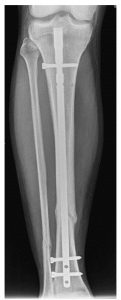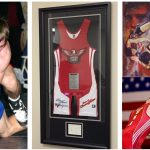Bears wide receiver Kevin White most likely sidelined for the entire 2015 season
While most people have heard of them, I know many, if not all, probably never imagined a diagnosis of shin splints would sideline Chicago Bears rookie wide receiver, Kevin White, for the 2015 season. White, who had been previously diagnosed with shin splints, underwent surgery to repair at least one stress fracture in his tibia. I have heard many sports reporters criticizing the Bears organization for not being truthful and concealing the facts of White’s injury, discussing “How it is shin splints one day and a stress fracture the next.” The fact is shin splints, a benign overuse injury, often occurs during grueling preseason training and can be easily confused with the more ominous tibial stress fracture.
Shin splints, also known as medial tibial stress syndrome, are an overuse injury believed to result from muscles in the lower leg repetitively pulling on their anchoring point along the inner aspects of the tibia (lower leg bone). This results in irritation and pain. Fortunately, they typically are treatable with modifying activities, rest, ice, stretching and therapeutic exercise. And, athletes often can continue to participate as long as they are improving.
Stress fractures, on the other hand, are more worrisome. If caught early, they require significant periods of rest to heal and a very gradual return to activity often precluding return to athletics during the same season. More advanced stress fractures require surgery to heal. In some special cases, surgery also can accelerate healing and return to sport.
 In the case of Kevin White, his surgeon determined the best treatment for his tibial stress fracture was to perform intramedullary nailing. This procedure is done by making an incision near the knee, creating an opening in the top of the tibia bone just below the knee joint and reaming with a flexible drill device along the length of the tibia intramedullary canal (central hollow) of the bone. Reaming creates injury, bone graft, and stimulates the stress fracture to heal and make room for the nail.
In the case of Kevin White, his surgeon determined the best treatment for his tibial stress fracture was to perform intramedullary nailing. This procedure is done by making an incision near the knee, creating an opening in the top of the tibia bone just below the knee joint and reaming with a flexible drill device along the length of the tibia intramedullary canal (central hollow) of the bone. Reaming creates injury, bone graft, and stimulates the stress fracture to heal and make room for the nail.
After reaming, the surgeon inserts a long metal rod (nail), often titanium or stainless steel, along the full length of the tibia from the knee to ankle. To add stability, screws are inserted across the bone and through holes in the nail above and below the fracture site. This surgical stimulation and stabilization of the fracture can accelerate healing time and return to weight bearing and athletics. However, sufficient rest and a gradual resumption of activities still must be observed to allow proper healing. Despite surgery and the nail, Kevin White’s tibia fracture may not heal if he returns too soon. Predicting when he will line up again after the stress fracture and significant surgery is challenging because some stress fractures can be difficult to get to heal. One thing I know for sure, the Bears already miss White’s presence on the field.









